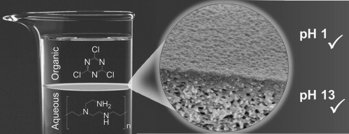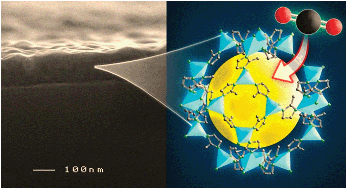Thin film synthesis
Various approaches are used to make thin films with specific properties. A particular topic is the the formation of films by localised reactions, such as interfacial polymerisation. The application of the films typically is aimed add molecular separations under demanding conditions, for instance high-T,p gas separation, organic solvent nanofiltration, or in mixtures with extreme pH.
Some examples:
Ultrathin inorganic-organic films

Ultrathin inorganic-organic films are developed based on polymerization reactions between silica based and carbon-based precursors. Typical routes involve the crosslinking of ammonium functionalized polyhedral silsesquioxanes with multifunctional organic monomers, by interfacial polymerization. The obtained thin hybrid materials can be regarded as giant covalent networks of organic and inorganic constituents, distributed homogeneously on the molecular scale. The hybrid characteristics of these networks are manifested by superior separation performance under conditions where polymer materials suffer from swelling and or plasticization. Current topics in this section are aimed at establishing chemistry-structure-property relations, and macromolecular design.
For example see: DOI: 10.1021/ja410047u (Featured in JACS Spotlights)
pH-stable polyamine membranes

When an interfacial polymerisation reaction occurs between a multifunctional amine in the aqueous phase and cyanuric chloride in the organic phase, the resulting polymer film does not contain carbonyl groups. Such carbonyl groups are integral part of the repeat unit of polyamides formed by interfacial polymerisation, and are very susceptible to hydrolysis under high-pH conditions. The cyanic chloride membranes indeed show extremely high stability in alkaline conditions, while maintaining a good separation performance.
For example see: DOI:10.1016/j.memsci.2014.12.045
Highly dense Metal Organic Framework films
 Metal–organic frameworks (MOFs) represent one of the fastest growing fields in materials chemistry. These porous hybrid organic–inorganic frameworks offer vast opportunities for development of technologically relevant and widely applicable materials. By facile step-by-step dip coating procedure, with very controlled withdrawal speed, uniform and thin ZIF-8 films have been prepared. The films are partly non-crystalline and do not contain substantial intercrystalline void space, which is manifested by a high refractive index. The dynamic response of the films to CO2 exposure resembles behaviour observed for non- equilibrium organic polymers.
Metal–organic frameworks (MOFs) represent one of the fastest growing fields in materials chemistry. These porous hybrid organic–inorganic frameworks offer vast opportunities for development of technologically relevant and widely applicable materials. By facile step-by-step dip coating procedure, with very controlled withdrawal speed, uniform and thin ZIF-8 films have been prepared. The films are partly non-crystalline and do not contain substantial intercrystalline void space, which is manifested by a high refractive index. The dynamic response of the films to CO2 exposure resembles behaviour observed for non- equilibrium organic polymers.
For example see: DOI:10.1039/c4cc04754k
